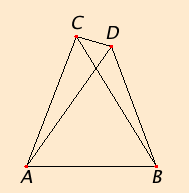Proposition 7
If possible, given two straight lines AC and CB constructed on the straight line AB and meeting at the point C, let two other straight lines AD and DB be constructed on the same straight line AB, on the same side of it, meeting in another point D and equal to the former two respectively, namely each equal to that from the same end, so that AC equals AD which has the same end A, and CB equals DB which has the same end B.

Join CD.
Since AC equals AD, therefore the angle ACD equals the angle ADC. Therefore the angle ADC is greater than the angle DCB. Therefore the angle CDB is much greater than the angle DCB.
Again, since CB equals DB, therefore the angle CDB also equals the angle DCB. But it was also proved much greater than it, which is impossible.
Therefore given two straight lines constructed from the ends of a straight line and meeting in a point, there cannot be constructed from the ends of the same straight line, and on the same side of it, two other straight lines meeting in another point and equal to the former two respectively, namely each equal to that from the same end.